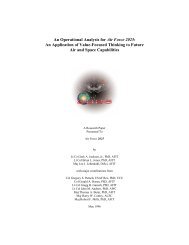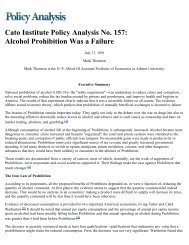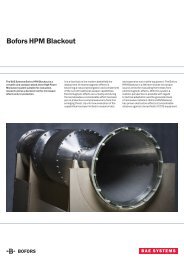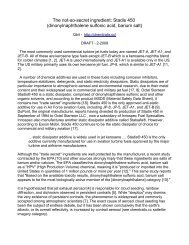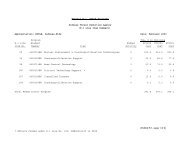Evaluating the Impacts of Aviation on Climate Change - Pa.op.dlr.de
Evaluating the Impacts of Aviation on Climate Change - Pa.op.dlr.de
Evaluating the Impacts of Aviation on Climate Change - Pa.op.dlr.de
Create successful ePaper yourself
Turn your PDF publications into a flip-book with our unique Google optimized e-Paper software.
Eos, Vol. 88, No. 14, 3 April 2007<br />
for both improved fuel efficiency and NO x<br />
reducti<strong>on</strong>).<br />
In 1992, aviati<strong>on</strong> c<strong>on</strong>tributed about 2% <str<strong>on</strong>g>of</str<strong>on</strong>g><br />
<str<strong>on</strong>g>the</str<strong>on</strong>g> total anthr<strong>op</strong>ogenic CO 2<br />
emissi<strong>on</strong>s and<br />
accounted for globally and annually averaged<br />
RF (GAARF) <str<strong>on</strong>g>of</str<strong>on</strong>g> about 0.02 watts per<br />
square meter. In c<strong>on</strong>trast, <str<strong>on</strong>g>the</str<strong>on</strong>g> GAARF for all<br />
n<strong>on</strong>-CO 2<br />
aviati<strong>on</strong> emissi<strong>on</strong>s combined<br />
(excluding cirrus clouds) is as large as that<br />
<str<strong>on</strong>g>of</str<strong>on</strong>g> CO 2<br />
al<strong>on</strong>e, though characterized by relatively<br />
large uncertainties. Figure 2 clearly<br />
indicates that <str<strong>on</strong>g>the</str<strong>on</strong>g> level <str<strong>on</strong>g>of</str<strong>on</strong>g> scientific un<strong>de</strong>rstanding<br />
to estimate climate resp<strong>on</strong>se due to<br />
n<strong>on</strong>-CO 2<br />
emissi<strong>on</strong>s for both cases ranges<br />
from fair to very poor.<br />
GAARF has wi<strong>de</strong>ly been used as a metric <str<strong>on</strong>g>of</str<strong>on</strong>g><br />
climate change for l<strong>on</strong>g-lived greenhouse<br />
gases. However, <str<strong>on</strong>g>the</str<strong>on</strong>g>re are c<strong>on</strong>tinued questi<strong>on</strong>s<br />
about its viability and usefulness for<br />
o<str<strong>on</strong>g>the</str<strong>on</strong>g>r greenhouse gases [Nati<strong>on</strong>al Aca<strong>de</strong>my<br />
<str<strong>on</strong>g>of</str<strong>on</strong>g> Sciences, 2005]. A fundamental issue is<br />
that some RFs (e.g., those from c<strong>on</strong>trails,<br />
induced cirrus clouds, and oz<strong>on</strong>e from NO x<br />
emissi<strong>on</strong>s) are spatially inhomogeneous and<br />
seas<strong>on</strong>ally varying. Therefore, RF from each<br />
<str<strong>on</strong>g>of</str<strong>on</strong>g> <str<strong>on</strong>g>the</str<strong>on</strong>g>se various sources could produce a different<br />
temperature change at <str<strong>on</strong>g>the</str<strong>on</strong>g> surface <str<strong>on</strong>g>of</str<strong>on</strong>g><br />
<str<strong>on</strong>g>the</str<strong>on</strong>g> Earth per unit change in GAARF. In additi<strong>on</strong>,<br />
values given in Figure 2 represent <str<strong>on</strong>g>the</str<strong>on</strong>g><br />
change in forcing from changes in c<strong>on</strong>centrati<strong>on</strong>s<br />
due to all prior aviati<strong>on</strong> activities.<br />
Since <str<strong>on</strong>g>the</str<strong>on</strong>g> atmospheric effects due to aviati<strong>on</strong><br />
emissi<strong>on</strong>s have very different timescales,<br />
ranging from several hundred years for CO 2<br />
to a few hours for c<strong>on</strong>trails, such RF estimates<br />
do not capture <str<strong>on</strong>g>the</str<strong>on</strong>g> relative importance<br />
<str<strong>on</strong>g>of</str<strong>on</strong>g> <str<strong>on</strong>g>the</str<strong>on</strong>g> short- and l<strong>on</strong>g-lived effects.<br />
While new scientific un<strong>de</strong>rstanding and<br />
data sets have become available since <str<strong>on</strong>g>the</str<strong>on</strong>g><br />
last IPCC report <strong>on</strong> <str<strong>on</strong>g>the</str<strong>on</strong>g> impact <str<strong>on</strong>g>of</str<strong>on</strong>g> aviati<strong>on</strong> <strong>on</strong><br />
climate change [IPCC, 1999], <str<strong>on</strong>g>the</str<strong>on</strong>g>re has been<br />
no comprehensive U.S. or internati<strong>on</strong>al<br />
attempt to update <str<strong>on</strong>g>the</str<strong>on</strong>g> assessment and associated<br />
uncertainties. Over <str<strong>on</strong>g>the</str<strong>on</strong>g> past several<br />
years, <str<strong>on</strong>g>the</str<strong>on</strong>g>re has been a lapse in research<br />
activities in <str<strong>on</strong>g>the</str<strong>on</strong>g> United States <strong>on</strong> <str<strong>on</strong>g>the</str<strong>on</strong>g> climate<br />
impacts <str<strong>on</strong>g>of</str<strong>on</strong>g> aviati<strong>on</strong>. In fact, a report to <str<strong>on</strong>g>the</str<strong>on</strong>g> U.<br />
S. C<strong>on</strong>gress <strong>on</strong> aviati<strong>on</strong> and <str<strong>on</strong>g>the</str<strong>on</strong>g> envir<strong>on</strong>ment<br />
[Waitz et al., 2004] clearly stated that <str<strong>on</strong>g>the</str<strong>on</strong>g> climate<br />
change impact <str<strong>on</strong>g>of</str<strong>on</strong>g> aircraft is a t<strong>op</strong>ic <str<strong>on</strong>g>of</str<strong>on</strong>g><br />
great c<strong>on</strong>tenti<strong>on</strong> and <str<strong>on</strong>g>the</str<strong>on</strong>g>re are no major U.S.<br />
research programs to address this.<br />
Un<strong>de</strong>r <str<strong>on</strong>g>the</str<strong>on</strong>g> Eur<strong>op</strong>ean TRADEOFF program,<br />
Sausen et al. [2005] updated <str<strong>on</strong>g>the</str<strong>on</strong>g> GAARFs for<br />
<str<strong>on</strong>g>the</str<strong>on</strong>g> year 2000 and compared <str<strong>on</strong>g>the</str<strong>on</strong>g>m against <str<strong>on</strong>g>the</str<strong>on</strong>g><br />
corresp<strong>on</strong>ding interpolated GAARFs based <strong>on</strong><br />
IPCC estimates for year 1992 and year 2050.<br />
The overall c<strong>on</strong>clusi<strong>on</strong> from that study<br />
remains unchanged: There are significant<br />
uncertainties in quantifying <str<strong>on</strong>g>the</str<strong>on</strong>g> climate<br />
impacts <str<strong>on</strong>g>of</str<strong>on</strong>g> aviati<strong>on</strong> emissi<strong>on</strong>s. Presently, <str<strong>on</strong>g>the</str<strong>on</strong>g>re<br />
are several Eur<strong>op</strong>ean research programs (e.g.,<br />
QUANTIFY) un<strong>de</strong>r way that have focused <strong>on</strong><br />
un<strong>de</strong>rstanding <str<strong>on</strong>g>the</str<strong>on</strong>g> impacts <str<strong>on</strong>g>of</str<strong>on</strong>g> aviati<strong>on</strong> <strong>on</strong><br />
atmospheric compositi<strong>on</strong> and climate.<br />
In North America, a 2006 worksh<strong>op</strong> <strong>on</strong> <str<strong>on</strong>g>the</str<strong>on</strong>g><br />
impacts <str<strong>on</strong>g>of</str<strong>on</strong>g> aviati<strong>on</strong> <strong>on</strong> climate change,<br />
which was sp<strong>on</strong>sored by <str<strong>on</strong>g>the</str<strong>on</strong>g> U.S. Fe<strong>de</strong>ral<br />
<str<strong>on</strong>g>Aviati<strong>on</strong></str<strong>on</strong>g> Administrati<strong>on</strong> (FAA) and assessed<br />
and documented <str<strong>on</strong>g>the</str<strong>on</strong>g> present state <str<strong>on</strong>g>of</str<strong>on</strong>g> scientific<br />
knowledge, i<strong>de</strong>ntified <str<strong>on</strong>g>the</str<strong>on</strong>g> key un<strong>de</strong>rlying<br />
Fig. 2. Estimates <str<strong>on</strong>g>of</str<strong>on</strong>g> globally and annually averaged radiative forcing (GAARF), measured in watts<br />
per square meter, from subs<strong>on</strong>ic aircraft fleet for (a) 1992 and (b) 2050. In both cases, <str<strong>on</strong>g>the</str<strong>on</strong>g> forcing<br />
represents <str<strong>on</strong>g>the</str<strong>on</strong>g> difference caused by historical <strong>op</strong>erati<strong>on</strong> <str<strong>on</strong>g>of</str<strong>on</strong>g> <str<strong>on</strong>g>the</str<strong>on</strong>g> fleet from its first introducti<strong>on</strong> to<br />
1992 or 2050. The forcing for CO 2<br />
is calculated using changes in CO 2<br />
c<strong>on</strong>centrati<strong>on</strong> relative to<br />
<str<strong>on</strong>g>the</str<strong>on</strong>g> historical <strong>op</strong>erati<strong>on</strong>. Values for o<str<strong>on</strong>g>the</str<strong>on</strong>g>r forcings are approximated by <str<strong>on</strong>g>the</str<strong>on</strong>g> steady state resp<strong>on</strong>ses<br />
to a fleet with repeated annual emissi<strong>on</strong>s at <str<strong>on</strong>g>the</str<strong>on</strong>g> 1992 and 2050 levels, respectively. See <str<strong>on</strong>g>the</str<strong>on</strong>g> text<br />
<strong>on</strong> why GAARF may not be a suitable metric for climate impacts <str<strong>on</strong>g>of</str<strong>on</strong>g> aviati<strong>on</strong> emissi<strong>on</strong>s. Adapted<br />
from IPCC [1999].<br />
uncertainties and gaps as well as <strong>on</strong>going<br />
and fur<str<strong>on</strong>g>the</str<strong>on</strong>g>r research nee<strong>de</strong>d, and explored<br />
<str<strong>on</strong>g>the</str<strong>on</strong>g> <strong>de</strong>vel<strong>op</strong>ment <str<strong>on</strong>g>of</str<strong>on</strong>g> climate impact metrics.<br />
The worksh<strong>op</strong> also sought to focus <str<strong>on</strong>g>the</str<strong>on</strong>g> scientific<br />
community <strong>on</strong> aviati<strong>on</strong>–climate change<br />
research needs.<br />
The data shown in Figure 2 clearly indicate<br />
that <str<strong>on</strong>g>the</str<strong>on</strong>g> largest uncertainties are associated<br />
with <str<strong>on</strong>g>the</str<strong>on</strong>g> indirect forcing resulting from<br />
changes in <str<strong>on</strong>g>the</str<strong>on</strong>g> distributi<strong>on</strong>s and c<strong>on</strong>centrati<strong>on</strong>s<br />
<str<strong>on</strong>g>of</str<strong>on</strong>g> oz<strong>on</strong>e (O 3<br />
) and methane (CH 4<br />
) as a<br />
c<strong>on</strong>sequence <str<strong>on</strong>g>of</str<strong>on</strong>g> aircraft NO x<br />
emissi<strong>on</strong>s, and<br />
<str<strong>on</strong>g>the</str<strong>on</strong>g> direct effects (and indirect effects <strong>on</strong><br />
clouds) from emitted aerosols and aerosol<br />
precursors, and effects associated with c<strong>on</strong>trails<br />
and cirrus cloud formati<strong>on</strong>. Because <str<strong>on</strong>g>of</str<strong>on</strong>g><br />
<str<strong>on</strong>g>the</str<strong>on</strong>g> issues with <str<strong>on</strong>g>the</str<strong>on</strong>g> RF metric noted above,<br />
worksh<strong>op</strong> participants were asked to<br />
examine those issues as well as alternatives<br />
for metrics. A brief summary <str<strong>on</strong>g>of</str<strong>on</strong>g> <str<strong>on</strong>g>the</str<strong>on</strong>g> major<br />
t<strong>op</strong>ics covered at <str<strong>on</strong>g>the</str<strong>on</strong>g> worksh<strong>op</strong> is found<br />
below; <str<strong>on</strong>g>the</str<strong>on</strong>g> full report is available at http://<br />
web.mit.edu/aeroastro/partner/reports/<br />
climatewrksp-rpt-0806.pdf.<br />
Emissi<strong>on</strong>s in <str<strong>on</strong>g>the</str<strong>on</strong>g> UT/LS<br />
and Resulting Chemistry Effects<br />
The potential importance <str<strong>on</strong>g>of</str<strong>on</strong>g> aircraft NO x<br />
emissi<strong>on</strong>s <strong>on</strong> tr<strong>op</strong>ospheric and stratospheric<br />
O 3<br />
is well recognized. <str<strong>on</strong>g>Aviati<strong>on</strong></str<strong>on</strong>g>-perturbed<br />
O 3<br />
can also affect <str<strong>on</strong>g>the</str<strong>on</strong>g> tr<strong>op</strong>ospheric<br />
oxidizing capacity, and thus levels <str<strong>on</strong>g>of</str<strong>on</strong>g> CH 4<br />
,<br />
an important greenhouse gas. The database<br />
<str<strong>on</strong>g>of</str<strong>on</strong>g> observati<strong>on</strong>s pertaining to <str<strong>on</strong>g>the</str<strong>on</strong>g> UT/<br />
LS has been greatly expan<strong>de</strong>d since <str<strong>on</strong>g>the</str<strong>on</strong>g><br />
IPCC assessment, and <str<strong>on</strong>g>the</str<strong>on</strong>g> new data are<br />
being used to evaluate global mo<strong>de</strong>ls. In<br />
additi<strong>on</strong>, improvements to <str<strong>on</strong>g>the</str<strong>on</strong>g> representati<strong>on</strong><br />
<str<strong>on</strong>g>of</str<strong>on</strong>g> atmospheric transport processes<br />
have resulted in better mo<strong>de</strong>ls for <str<strong>on</strong>g>the</str<strong>on</strong>g> compositi<strong>on</strong><br />
and fluxes <str<strong>on</strong>g>of</str<strong>on</strong>g> O 3<br />
and o<str<strong>on</strong>g>the</str<strong>on</strong>g>r species<br />
in this regi<strong>on</strong>.<br />
However, uncertainties in mo<strong>de</strong>l predicti<strong>on</strong>s<br />
and gaps in un<strong>de</strong>rstanding remain. The<br />
large disagreements between <str<strong>on</strong>g>the</str<strong>on</strong>g> mo<strong>de</strong>led<br />
and measured abundances <str<strong>on</strong>g>of</str<strong>on</strong>g> hydrogen<br />
oxi<strong>de</strong>s (HO x<br />
) and NO x<br />
gases in <str<strong>on</strong>g>the</str<strong>on</strong>g> upper tr<strong>op</strong>osphere<br />
point to ei<str<strong>on</strong>g>the</str<strong>on</strong>g>r measurement errors<br />
or errors in tr<strong>op</strong>ospheric chemical mechanisms<br />
and rates. There remain uncertainties<br />
related to <str<strong>on</strong>g>the</str<strong>on</strong>g> removal <str<strong>on</strong>g>of</str<strong>on</strong>g> atmospheric NO x<br />
through <str<strong>on</strong>g>the</str<strong>on</strong>g> coupling <str<strong>on</strong>g>of</str<strong>on</strong>g> large-scale transport,<br />
c<strong>on</strong>vecti<strong>on</strong>, cloud, and precipitati<strong>on</strong> processes.<br />
A <strong>de</strong>tailed intercomparis<strong>on</strong> <str<strong>on</strong>g>of</str<strong>on</strong>g> current<br />
mo<strong>de</strong>ls and measurements, emphasizing<br />
<str<strong>on</strong>g>the</str<strong>on</strong>g> UT/LS and free tr<strong>op</strong>osphere, is nee<strong>de</strong>d.<br />
This process should lead to mo<strong>de</strong>l<br />
improvements and <str<strong>on</strong>g>the</str<strong>on</strong>g> reducti<strong>on</strong> <str<strong>on</strong>g>of</str<strong>on</strong>g> uncertainty<br />
in mo<strong>de</strong>l predicti<strong>on</strong>s. Also nee<strong>de</strong>d is<br />
an expan<strong>de</strong>d analysis <str<strong>on</strong>g>of</str<strong>on</strong>g> <str<strong>on</strong>g>the</str<strong>on</strong>g> wealth <str<strong>on</strong>g>of</str<strong>on</strong>g> data<br />
currently obtained in <str<strong>on</strong>g>the</str<strong>on</strong>g> UT/LS by aircraft<br />
and satellite platforms with a focus <strong>on</strong><br />
regi<strong>on</strong>s perturbed by impacts <str<strong>on</strong>g>of</str<strong>on</strong>g> aviati<strong>on</strong><br />
emissi<strong>on</strong>s. Presently, most analyses <str<strong>on</strong>g>of</str<strong>on</strong>g> aviati<strong>on</strong><br />
impacts are evaluated relative to current<br />
atmospheric c<strong>on</strong>diti<strong>on</strong>s. Estimates <str<strong>on</strong>g>of</str<strong>on</strong>g><br />
projected climate resp<strong>on</strong>se should c<strong>on</strong>si<strong>de</strong>r<br />
<str<strong>on</strong>g>the</str<strong>on</strong>g> atmospheric c<strong>on</strong>diti<strong>on</strong>s expected<br />
at <str<strong>on</strong>g>the</str<strong>on</strong>g> time <str<strong>on</strong>g>of</str<strong>on</strong>g> future fleet. In <str<strong>on</strong>g>the</str<strong>on</strong>g> l<strong>on</strong>ger<br />
term, field campaigns are required to<br />
address issues with HO x<br />
-NO x<br />
chemistry in<br />
<str<strong>on</strong>g>the</str<strong>on</strong>g> UT and to better un<strong>de</strong>rstand background<br />
processes.<br />
C<strong>on</strong>trails and Cirrus Clouds<br />
C<strong>on</strong>trails form if ambient air al<strong>on</strong>g <str<strong>on</strong>g>the</str<strong>on</strong>g><br />
flight track is col<strong>de</strong>r and moister than a<br />
threshold based <strong>on</strong> known <str<strong>on</strong>g>the</str<strong>on</strong>g>rmodynamic<br />
parameters. Early c<strong>on</strong>trail evoluti<strong>on</strong> <strong>de</strong>pends,<br />
in poorly un<strong>de</strong>rstood ways, <strong>on</strong> aircraft and<br />
engine emissi<strong>on</strong> parameters. In ice-supersaturated<br />
air masses, c<strong>on</strong>trails can organize<br />
<str<strong>on</strong>g>the</str<strong>on</strong>g>mselves in regi<strong>on</strong>al-scale clusters that<br />
add significantly to <str<strong>on</strong>g>the</str<strong>on</strong>g> natural high cloud<br />
cover and have <str<strong>on</strong>g>the</str<strong>on</strong>g> potential, albeit with<br />
large uncertainties, for a relatively large positive<br />
radiative forcing. Factors c<strong>on</strong>trolling <str<strong>on</strong>g>the</str<strong>on</strong>g><br />
radiative pr<strong>op</strong>erties <str<strong>on</strong>g>of</str<strong>on</strong>g> cirrus clouds and




